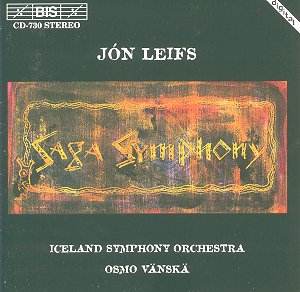Jón LEIFS
(1899-1968)
Saga Symphony
(1941)
 Iceland SO/Osmo
Vänskä
Iceland SO/Osmo
Vänskä
rec Reykjavik, March 1995
world premiere complete
recording
 BIS-CD-730
[54.27]
BIS-CD-730
[54.27]
Crotchet
AmazonUK
AmazonUS
Amazon
recommendations

Leifs wrote this work during the period March 1941 to July 1942. It was written
in the wake of the premiere of the Organ Concerto during which most of the
Berlin audience walked out leaving only 20 in the hall at the end of the
work.
The composer lived with his German concert pianist wife at Ehrbrucke at the
time. In return for his discretion and occasional complicity (the Nazis broadcast
one of his talks to Iceland) his Jewish wife (a concert pianist, blacklisted
of course) and two daughters were not harmed.
The Saga Symphony also known as Saga Heroes was, in some part,
inspired by the pattern of Liszt's Faust Symphony which Leifs had
heard in Leipzig in 1916. Its genesis and movement titles owe all to Leifs'
identification with the same Edda characters that in other Aryan contexts
should have guaranteed Leifs a ready audience in Hitler's Germany. However
his music was never going to be ideologically acceptable.
What of it? It is instantly memorable for its unadorned style. Long-lined
ideas are not a hallmark of his writing. In the first movement
(Skarphedinn) and the fourth (Glamr og Grettir) Leifs batters
us with a sequence of exciting off-beat hammer blows punched out with great
definition. A wide dynamic range is called for from the just audible to the
deafening. Both extremes are there in the first movement. Schuman-like writing
for the brass can be heard in Gudrun Osvifrsdottir (2nd) movement
mingled with a declamatory expression heard during the wilder moments in
Nielsen 5. The scherzo Bjorn ad baki Kara whispers, and patters at
first like a light-footed night-chase with much pizzicato and with convulsively
spat out percussive shots and clangs - a Leifs signature. The courtly dances
of the Thormodr Kolbrunarskald prepare the way for the raw, spare
punches of a finale that also offers some moments of affecting rural piping
of a decidedly Celtica Nova type. However the abiding impressions
are of a welter of stamping, of activity always controlled and defined but
goaded onwards. If ultimately this does not have truly symphonic shaping
the work's tableaux are the stuff of the frosty dreams which make up the
sagas of Njal, Gretts, Laxdaela, Fostbraeda and the Heimskringla.
The orchestra includes six nordic lurs heard at end of the fifth and final
movement. Unusual instruments used include various sizes and type of stone,
an iron anvil, shields of wood, leather and iron and big wooden hammers truck
against the sides of huge wooden containers.
The symphony was premiered during the September 1950 Nordic Music Days Festival
in Helsinki with Jussi Jalas conducting. Jalas directed the work again in
1972 this time in Reykjavik and four years later recorded it for release
on the Iceland Music Information Centre LP now superseded by this disc. The
Jalas LP had each of the five movements considerably shortened. Counting
recording sessions this probably only its fifth performance.
Surely the definitive recording of one of the strangest of symphonies from
the 1940s - allied to no school or calling - sui generis.
Rob Barnett

